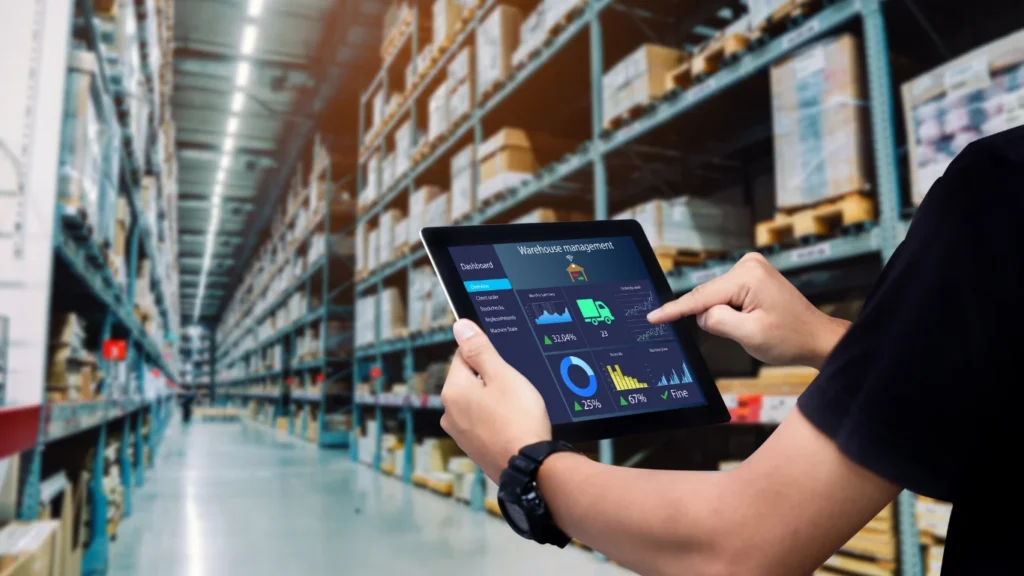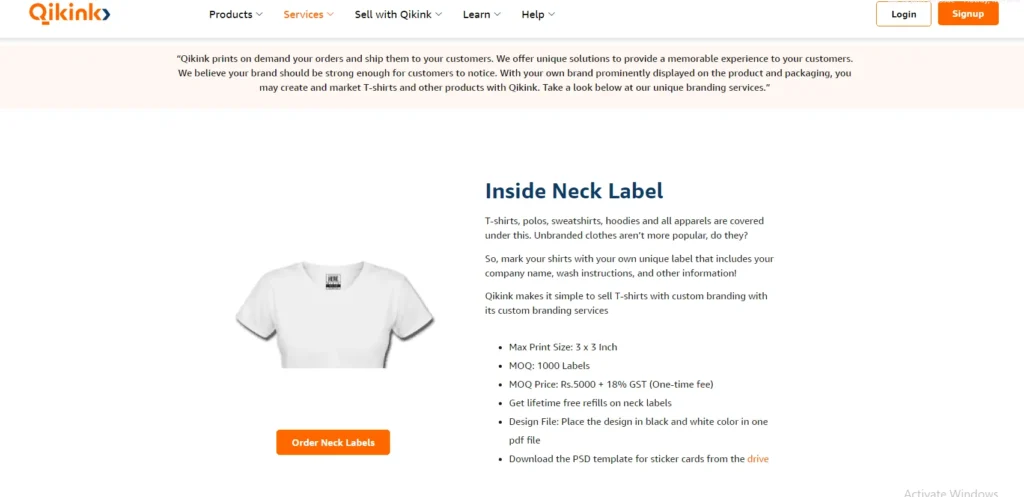What is eCommerce inventory management?
E-commerce inventory management is the process of monitoring and regulating the movement of goods or products, including selling, storing, tracking inventory levels, and restocking, for online store businesses.
By continually optimizing inventory, we make decisions about when to restock orders and find the right balance between supply and demand.
A strong ecommerce inventory management system ensures that customer orders are fulfilled efficiently, avoiding stockouts and enabling quick responses to customer demand. It also ensures the availability of the right products when needed.
What is online inventory management?

Online inventory management is a software solution that helps businesses in managing inventory in an online environment.
It assists in monitoring stock movements, stock levels, and restocking needs.
Additionally, it provides a centralized platform to streamline inventory activities in real time.
Benefits of online inventory management:
Here are some benefits of an online inventory management system to help you understand its advantages:
1. Real Time Tracking
This system helps businesses track inventory levels in real-time, allowing them to view stock levels and receive real-time updates. These updates help prevent stockouts, overstocking, and inefficient order fulfillment processes.
This system helps manage customer orders, including order processing and fulfilment, ensuring proper order control and reducing the risk of out-of-stock and overstock situations.
3. Barcode Scanning
Online inventory systems often include barcode scanning, which helps accurately identify stock and fulfill orders. This feature also reduces errors and manual data entry.
4. Reporting and analysis
It generates reports and analyses, offering valuable insights into stock levels, sales performance, and product restocking data. These insights are essential for supporting business growth and effectively meeting customer demands.
What are the challenges in inventory management for ecommerce businesses?
1. Stockouts
One of the main challenges for e-commerce businesses is balancing stock levels. Stockouts can lead to order delays and lost sales.
The solution to overcome stockout challenges:
Utilize forecasting tools and real-time inventory tracking systems to gain insights into inventory status. By analyzing accurate sales data and trends, you can make informed decisions about restocking orders and avoid stockout issues.
Examples of tools for real-time inventory tracking systems:
- Zoho Corporation
- Cin7
- Barcode Scanning System
- NetSuite
2. Customer Demand Forecasting
The primary challenge in inventory management is accurately predicting customer demand. Inaccurate forecasts can lead to overstocking, resulting in increased storage costs.
The solution to overcome Inaccurate demand forecast challenges:
- Use advanced analytics and reports to accurately forecast demand. It helps prevent both overstocking and stockout issues in your inventory levels.
- By implementing real-time data analysis and monitoring customer behaviour, enhance the accuracy of demand forecasting.
Example software for demand forecasting:
3. Effective Order Management
Managing high volumes of orders and ensuring timely fulfilment can be challenging in e-commerce. When multiple sales channels are involved, tracking and processing orders efficiently during peak periods becomes particularly challenging, often leading to stockouts.
The solution to overcome order management challenges:
You can implement ERP systems or inventory management software to automate order processing, tracking, and inventory updates across various platforms. This ensures accurate stock information and reduces errors.
Examples of Inventory management software:
- Zoho
- inFlow
- Katana
- Cin7
4. Efficient Warehouse Management

E-commerce stores struggle with warehouse efficiency due to manual order management processes like stock counting, picking, and packing, leading to inefficiencies. Sometimes Misplaced stock can significantly slow down the entire order fulfillment process.
The solution to overcome Warehouse inefficiencies challenges:
By implementing ERP inventory management systems or barcode scanning technology, you can automate inventory tracking, optimize order processing, and enhance overall warehouse efficiency. This helps reduce human errors, minimize handling time, and increase productivity.
5. Deadstocks
Avoiding dead stock is a common challenge for e-commerce stores as slow-moving or obsolete products occupy warehouse space.
The solution to overcome Deadstock challenges:
To tackle this issue, stores can use better inventory tracking and analysis. By checking how products are selling, finding slow sellers, and trying things like special deals or selling in bundles, can help improve inventory turnover and reduce dead stock.

For online stores, managing the supply chain well is super important, especially when dealing with lots of different suppliers and delivery times. It can be tricky to keep everything organized and make sure things get restocked on time.
The solution to overcome supply chain challenges:
To handle these issues, having good systems for supplier management and clear communication is key. Also, working with different suppliers and using data to predict demand can make inventory management smoother.
- Good inventory management is crucial for eCommerce success.
- Overcoming challenges like predicting demand accurately, managing orders efficiently, keeping track of inventory, running warehouses smoothly, and handling supply chains well helps keep customers satisfied and minimize costs, leading to better profits.
Why do you need ecommerce inventory management?
- You need ecommerce inventory management because it’s crucial for your online business.
- It helps you track product levels, avoid overstock or low stock issues, and adjust orders as needed, which ultimately saves you money.
- Plus, partnering with an inventory management service ensures accurate inventory levels on your selling platforms, enhancing the customer experience.
Reasons why ecommerce inventory management is essential
Customer Satisfaction
Keeping inventory accurate means making sure the items on your website are really available. When customers can rely on getting what they order quickly, it makes their shopping experience better.
To Avoid Overstock and Stockout issues
it helps you avoid having too much or too little stock. When you have too much, you’re using up money and space.
If you don’t have enough, you miss out on sales and upset customers. Managing inventory well stops these problems by making sure you restock on time and never run out of products.
Sell on demand products (seasonal or trending products)
E-commerce stores often sell products that are popular during certain seasons or trends. With good inventory management, they can change how much stock they have based on what’s popular at the time. This helps them keep up with seasonal changes and new trends in the market.
Demand Forecasting
Inventory management systems have tools that accurately predict how much demand there will be for products in the future. This helps e-commerce businesses decide how much to buy and how to advertise their products.
How do you manage inventory in eCommerce?
To manage inventory in eCommerce have some key strategies.
- Use inventory software for inventory tracking.
- To Keep extra stock available to avoid running out during unexpected increases in demand or supply chain issues.
- Use just-in-time inventory practices to save money and avoid having too much inventory.
- Regularly review your product catalogue to find slow-selling or outdated items.
- Distribute inventory across multiple locations to speed up shipping and cut costs.
- Integrate your e-commerce platform with inventory management and order fulfilment systems to enable seamless order processing, inventory updates, and shipment tracking.
- Create easy-to-understand return policies and processes for customers. It simplifies returns to speed up processing and keep inventory records accurate.
- Offer customers different shipping choices like standard, expedited, and same-day delivery.
- Monitor performance metrics for improvements.
Explore from wide range of custom products

Do you need inventory for ecommerce?
- No, inventory is not necessarily required for ecommerce. You can start an ecommerce business without inventory through a method called dropshipping.
- With dropshipping, suppliers handle inventory management, receive orders, ship them to customers, and restock based on demand.
- You can primarily focus on marketing your brand.
Recommended Guide: Start Your Dropshipping Business in India
What are the methods and techniques in inventory management?
Inventory Management Software utilizes different methods and techniques to handle inventory levels, track stock movement, and streamline inventory processes.
Here are the techniques and methods in inventory management:
1. ABC Analysis
ABC analysis categorizes inventory items into three groups based on their value and importance: A, B, and C. This technique is helpful for managing products of varying importance and value.
- Group A includes the most valuable and important items needing close monitoring.
- Group B contains moderately valuable items requiring moderate monitoring,
- Group C consists of the least valuable items needing minimal attention.
2. Just-in-time Inventory
Just-in-time (JIT) is an inventory management method where goods are ordered only when supplier needed. The goal is to cut down on inventory costs and boost turnover by keeping stock levels low and ordering more as needed. This helps companies minimise excess inventory.
3. Dropshipping
In dropshipping, retailers avoid stocking products and instead purchase them from a third party supplier, who ships directly to the customer. This method minimizes warehousing needs and associated inventory costs.
4. Bulk shipments
it means to ship products in bulk in a single shipment. Also, Ordering inventory in bulk may lead to discounts from suppliers, but it must be balanced with storage constraints and carrying expenses.
5. Safety Stock
One key method in inventory management is maintaining safety stock. This involves keeping extra inventory on hand to handle unexpected fluctuations in demand or supply chain disruptions.
Safety stock acts as a buffer, ensuring that you can fulfill customer orders even during challenging times.
6. EOQ (Economic Order Quantity)
The Economic Order Quantity (EOQ) model helps businesses find the best order quantity for a product. It balances the costs of ordering too much or too little inventory by considering both the cost of placing orders and the cost of holding inventory.
7. Perpetual Inventory System
The perpetual inventory system keeps track of inventory levels in real time. Whenever a sale is made or a product is received, the system updates the inventory records immediately to show the current stock levels.
8. Batch Tracking
Batch tracking groups similar items together and assigns them a specific batch or lot number for easy monitoring.
This helps in tracking expiration dates and identifying any defective items. It’s particularly helpful in industries where knowing production or expiration dates is important.
9. Cycle Counting
Cycle counting is a method where you count a small part of your inventory regularly instead of doing one big count all at once. This helps to keep track of stock levels accurately without interrupting normal business operations.
10. Inventory Tracking
The software uses barcode or RFID scanning to track batches or lots of items. It automates inventory tracking and control, making it easier to manage inventory efficiently.
11. Consignment
In consignment inventory management, you pay your supplier only after the product is sold, and they retain ownership of the inventory until it’s sold.
12. Cross-Docking
Cross-docking is a technique where items are directly transferred from a supplier’s truck to the delivery truck, bypassing the need for warehousing.
13. Demand Forecasting
Forecasting relies on analyzing previous sales data to anticipate future demand. This predictive analytics technique is essential for predicting customer demand accurately.
14. FIFO and LIFO
FIFO (First In, First Out) means selling the oldest stock first, while LIFO (Last In, First Out) assumes that recent purchases are the most expensive and sold first, based on the idea that prices typically increase over time.
15. Six Sigma
Six Sigma is a statistical tool used for process improvement, particularly in processes with high variability or error rates. It’s a data-driven approach aimed at reducing waste in businesses, including inventory management processes.
16. Lean Six Sigma:
This approach merges lean management and Six Sigma methodologies to eliminate waste and enhance efficiency in inventory management. Lean focuses on reducing non-value adding elements or waste from the system or process.
Why use eCommerce inventory management software?
Managing inventory well is crucial for a successful online store. Using advanced software can help make this easier.
Look for systems that offer features like real-time tracking and predicting demand. Choose software that fits your needs and can grow with your business.
1. Keeping inventory in sync across sales channels
Ecommerce inventory management software syncs your inventory across multiple sales platforms, like your website, Amazon or Shopify.
This way, you can avoid overselling or underselling your products. Plus, you can easily update product info from one central dashboard.
2. Streamlining operations with barcode or RFID technology

You can keep track of inventory by scanning barcodes, RFID(Radio-frequency identification) tags, or QR codes, which helps minimize mistakes. Also, Inventory software streamlines warehouse operations for better efficiency.
3. Manage your suppliers and orders
Inventory management software simplifies supplier and order management, ensuring adequate stock levels to meet demand. They set reorder points for timely alerts when inventory is low.
4. Anticipating demand with predictive analytics
Inventory software helps you predict how much you’ll sell and plan for busy times. By looking at past sales and trends, you can figure out how much stock you’ll need.
This predictive analytics technique is essential for predicting customer demand accurately.
How Qikink helps you start dropshipping without any inventory management
Starting your dropshipping business is simple with Qikink’s comprehensive dropshipping services. With Qikink, you can easily sell products without the hassle of managing inventory. Focus on growing your business and serving your customers while Qikink takes care of printing, packing, and shipping.
Here’s why you choose Qikink’s dropshipping platform for starting your business
1. No Signup Fees:

Qikink does not charge any signup fee or minimum deposit. You can just signup and start placing orders by paying for the orders.
2. E-commerce Integration:
Easily integrate your Shopify and WooCommerce stores with us for seamless order processing through complete automation.
3. Product Range:

We have India’s largest range of products, from apparel to accessories, for dropshipping.
4. Print Options:

- Qikink provides the best high-quality DTG and DTF printing services with no MOQ(Minimum Order Quantity), quick turnaround time, eco-friendly practices, and unparalleled quality.
- Apart from having the largest Direct to Garment facility in India, Qikink is also equipped with Eco-Solvent, UV, Sublimation, Screen Printing, and Digital Transfer printers to fulfil Print on Demand and bulk orders.
5. Custom Branding:

We expect your brand to be loud enough to be better experienced by your customers. We offer unique custom branding options. The product, printing, packaging, and shipping label are white labelled and available with custom branding options. Also, Qikink provides free custom branding with your logo on every courier packet.
6. Ships Worldwide:
Qikink partners with top courier companies like FedEx, DHL, and Aramax for fast and reliable international shipments.
Recommended Resources
Frequently Asked Questions
What are the benefits and drawbacks of having surplus inventory?
Advantages-
You may set up wholesale pricing to sell extra items in the warehouse.
You always address the needs of your customers.
Order fulfillment on time
Disadvantages-
Increased Storage Costs
Higher probability of inventory loss and damage
Deadstock
Why is inventory management essential for a business?
Inventory management is essential for streamlining your day-to-day operations. Keeping track of your inventory and orders helps you avoid losses. You can only concentrate on business expansion without concern about lists. While you may be able to ignore it in the early stages of your smaller business, as you grow more extensive, you will incur losses if you do not have efficient inventory management.
What are the advantages of adopting inventory management software?
Still, do you require inventory management software? If you’re still on the fence, consider the following advantages of adopting this sort of software:
- A more efficient stocking procedure
- Enhanced productivity
- enhanced client service
- increased profitability
- Current inventory counts
- Monitoring numerous warehouses from a single interface
- The capacity to automate critical jobs
- Inventory optimization techniques for detecting old stock
- Purchase and sales order management tools
- Analytics for prediction
What is the primary goal of Ecommerce Inventory Management for an online store?
As an online store, E-commerce Inventory Management’s primary goal is to ensure the availability of the right products in the correct quantity and at the right time to meet customer demand while minimizing costs associated with overstocking and understocking.
Can you explain the risks associated with poor inventory management in e-commerce?
When e-commerce businesses have poor inventory management, they risk stockouts, overstocking, increased holding costs, order delays, dissatisfied customers, and wasted resources, ultimately leading to lost sales, decreased revenue, and damage to brand reputation.
What are the critical components of an effective inventory management system for e-commerce businesses?
The key components to having an effective inventory management system for e-commerce businesses include accurate demand forecasting, real-time inventory tracking, safety stock management, efficient order fulfillment processes, and data analytics for informed decision-making.
How does e-commerce inventory Management differ from traditional inventory management for brick-and-mortar stores?
E-commerce Inventory Management is different from traditional inventory management for brick-and-mortar stores because it requires real-time tracking and monitoring of inventory levels across multiple channels and locations and the ability to manage and fulfill orders from anywhere at any time.
What role does real-time tracking play in Ecommerce Inventory Management?
Real-time tracking is crucial in Ecommerce Inventory Management, providing accurate and up-to-date information on inventory levels, order status, and shipping details. It enables businesses to make informed decisions about inventory replenishment, safety stock management, and order fulfillment, ultimately improving customer satisfaction and increasing revenue.















